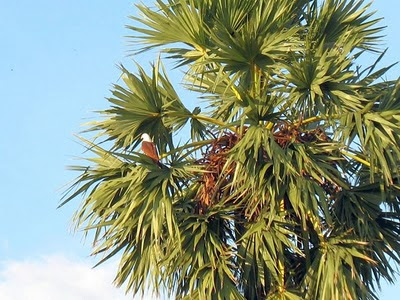The below two stories illustrate the power over birds and nature exhibited by the great mahan, Sri Seshadri Swamigal.
Calling out for Garuda Birds (Brahmini Kite):
“One one occasion the writer was given a send-off by Swamiji. It was 8 a.m. They were passing near Sadhu Chatram. Swamiji put his hands around the writer’s neck and stood for a while. In the distant sky it appeared as if a lone bird was flying. Pointing to that, Swamiji asked the writer, “Is that a Garuda?” The writer replied, “Yes, it looks like a Garuda.” At that time Swamiji made a gesture with his hands as if calling that bird. He bade farewell to the writer saying, “That bird will come, you can go.”
Hardly had the writer walked on a few yards on the way to the railway station, when two Garuda birds flew very close to him, one on his left and another on his right. As Swamiji had said that the birds would come hundreds of Garuda birds flocked there. It was if the devotee’s journey should have a good augury. One could normally expect a few such birds like sparrows, crows. But hundreds of Garuda birds would not normally be seen. The confusion is irresistible that Swamiji had purposely called them in.”
 |
| Beautiful Brahminy Kite |
The Garuda bird in Hindu mythology is the vahana (vehicle) of Lord Vishnu and in daily life is believed to be the Brahminy Kite. To find out more about the Brahminy Kite, go to this link here, and for in-depth information about Garuda mythology go to this link here. Incidentally the photograph at the top of this page is of the Brahminy Kite.
Calling various Birds:
“Venkatachala Mudaliar and his wife Subbalakshmi Ammal were earnest devotees of Swamiji. Quite often Swamiji used to visit them, take food in their house and talk to them in a jolly fashion. In the centre of their house there were two Poovarasa (Portia) trees and two drumstick trees. It was a new moon day. Swamiji dropped in a 4 p.m, and said, 'Subbalakshmi, come here, I will show you some fun.'
When she asked what he was going to show, Swamiji was looking into the sky through the open verandah and raised his hands calling out, “Come! Come!” Immediately one crow came, then another crow flew in, then five, then, fifty, hundred crows flew in; likewise a number of other species of birds like pigeons, parrots, various types of sparrows—yellow sparrows, black sparrows, etc., all flew in.
They all crowded the whole place including the neighbouring house, sitting on the ground, on the roof, on the trees and started making a noise and jumping hither and thither and playing. Swamiji was standing in their midst and played with the birds. Subblalakshmi was watching the scene with curiosity. A few minutes elapsed when she told Swamiji: 'You have called the birds from somewhere and are playing with them like this! After all they will also feel hungry and thirsty. Will their young ones not feel anxious?' Swamiji asked, 'But should I ask them to go back?' Saying that, he took a strand from his shoulder cloth and blew it. Immediately all the birds departed.”









